
Sheridan College
Architectural Technology
ARCH29969 - STUDIO 3
MODULE 3: DESIGN CONCEPTUALISATION
Learning Outcomes
By the end of this Module, students will:
1.0 What is Design?
If you ask ten different people, you will get ten different answers. Design is a very personal thing, since the process involves the innermost workings of one's mind transferred to the existence of a singular, series or grouping of objects.
It is better, right now, to define design within the context of the architectural program you are in, and it's typology. We are training you to be Architectural Technologists and Technicians: these are specific roles in the field of architecture. So, what does design mean to the Technologist and the Technician?
"...design is a distinct discipline. It involves unique skills to the molding of these emerging technologies into a form that serves our society, and reflects its values. Far from being a luxury, informed design is essential from the technical, economic, and cultural perspective..." (Buxton, 2007).
2.0 Design Synthesis
The term "Design Synthesis" is the all-encompassing term that describes the process your action of designing results in. These results could be:
a drawing;
an object;
a room layout;
an enclosure;
a building;
a city;
The act of designing brings together many different entities, thoughts, ideas, and different components of a problem, and combines these all into a singular solution. This is the opposite to "analysis", where that action breaks apart an item into its constituent parts in order to understand that item.
Design decisions are largely based on some form of "Performance Criteria": the ideas generated through a particular need. Look at the article below, and we can see how different criteria can change the approach to the design of a space:
"Kill Your Meeting Room — The Future’s in Walking and Talking." (Merchant, 2013).
So, the question remains, how does one go about designing? How does an individual take all of their given performance criteria, thoughts and ideas, and create that one solution that solves all the various, and varying, issues?
3.0 Design Process
Process is best explained using diagrams...notice the circular approach to the process. Therefore, does it ever end?


3.1 The Space Planning Process - Defining the Problem
3.1.1 Interviews
3.1.2 Observations
3.1.3 Establish architectural parameters
3.1.4 Organize collected data (First Phase Program)
3.1.5 Research the unknowns
3.1.6 Analyze the data
3.1.7 Interpret and diagram the data (The Complete Program)
3.1.8 Summarize the data (The Finished Document)
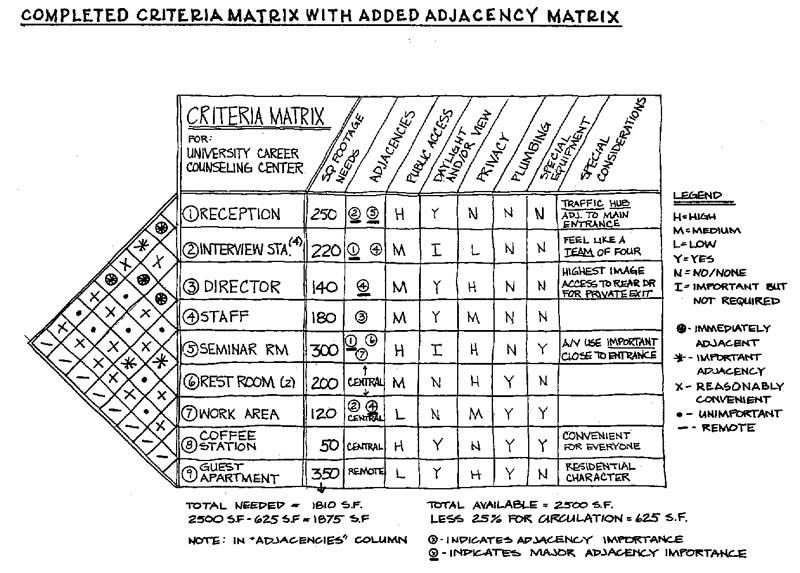
An example of a written (and witty) manifesto of DESIGN INTENT...."This Foyer is Going to be Epic." (Brown, 2011).
3.2 The Space Planning Process - The First Planning Steps
3.2.1 Bubble Diagramming
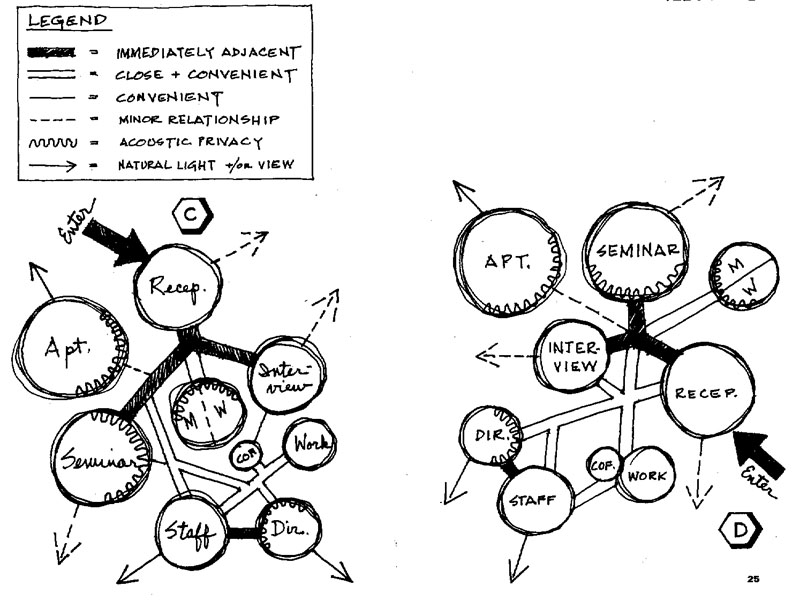
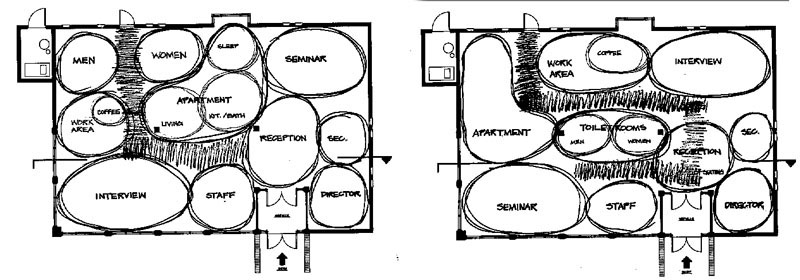
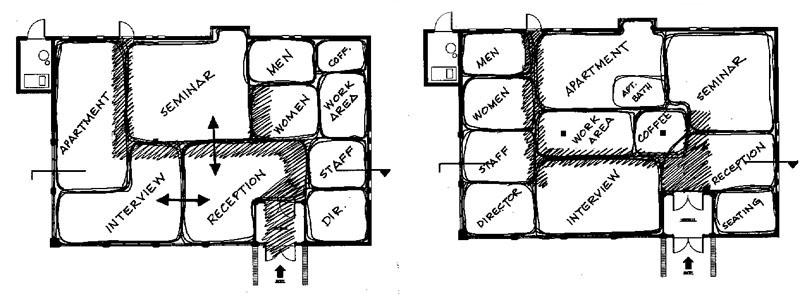
3.2.2 Block Planning
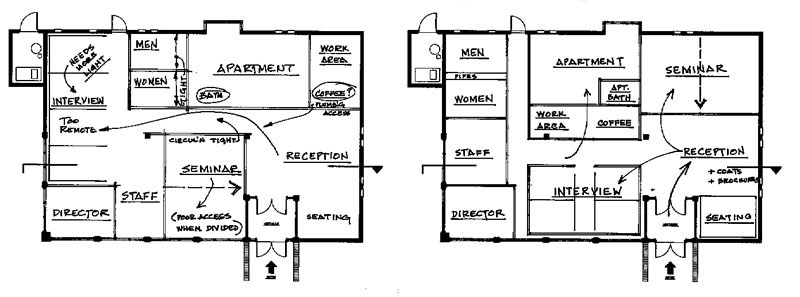
3.2.3 Planning Rules of Thumb
| Space | Approx. Area (sq.ft.) | Approx Area (sq.m) |
| Typical powder room (two piece) | 20 - 30 | 1.8 - 2.8 |
| Typical apartment bathroom (therr piece) | 35 - 45 | 3.3 - 4.2 |
| Typical apartment kitchen (not studio or efficiency) | 65 - 80 | 6.0 - 7.4 |
| Lounge (hotel lobby, student centre) | 20 - 30 per person | 1.8 - 2.8 per person |
| Waiting/reception room (doctor's office, school registration centre) | 15 - 20 per person | 1.4 - 1.8 per person |
| Conference room (business, professional offices, institutions) | 20 - 30 per person | 1.8 - 2.8 per person |
| Assembly rooms (stack chairs for lectures - schools, hotels) | 10 - 15 per person | 0.9 - 1.4 per person |
| Auditorium (fixed seating) | 8 - 14 per person | 0.75 - 1.3 per person |
| Dining: high school cafereria | 10 - 15 per person | 0.9 - 1.4 per person |
| Dining: a mid-priced restaurant | 18 - 25 per person | 1.7 - 2.3 per person |
| Dining: an elegant restaurant | 30 - 40 per person | 2.8 - 3.7 per person |
| Offices: minimal private work space | 80 - 100 | 7.4 - 9.3 |
| Offices: standard work + consulting space | 120 - 150 | 11.2 - 14.0 |
| Offices: executive with lounge seating | 200 - 300 | 18.6 - 27.9 |
3.3 The Space Planning Process - Rough Floor Plans
3.3.1 Major Space Allocation
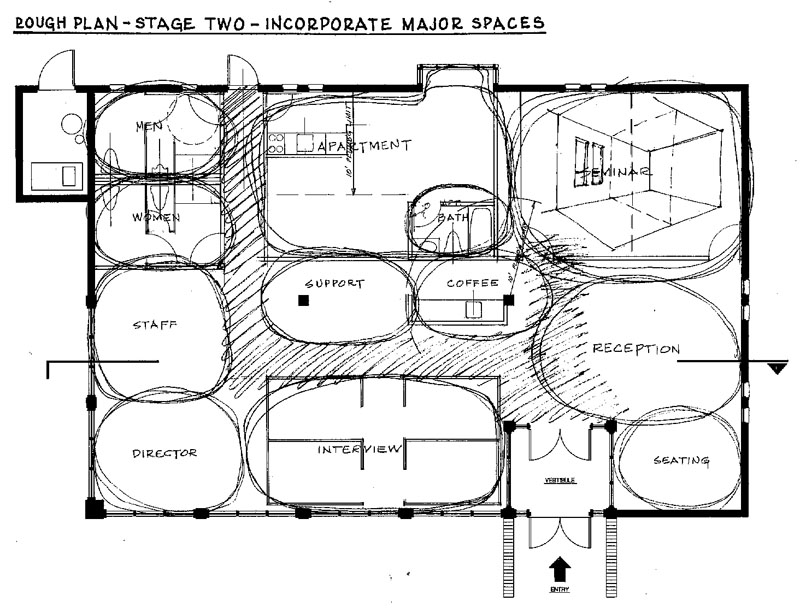
3.3.2 Circulation Spaces
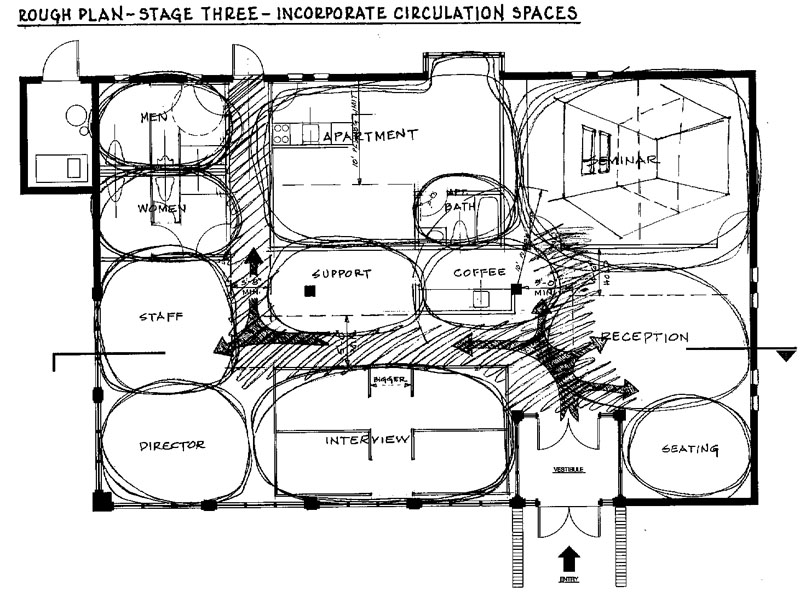
3.3.3 Room Allocations
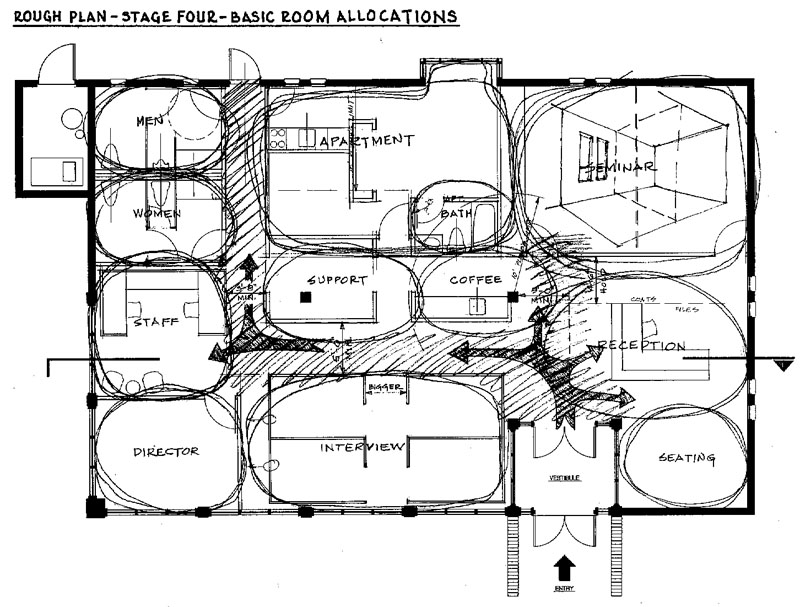
3.3.4 Fixtures, Fitments and Equipment
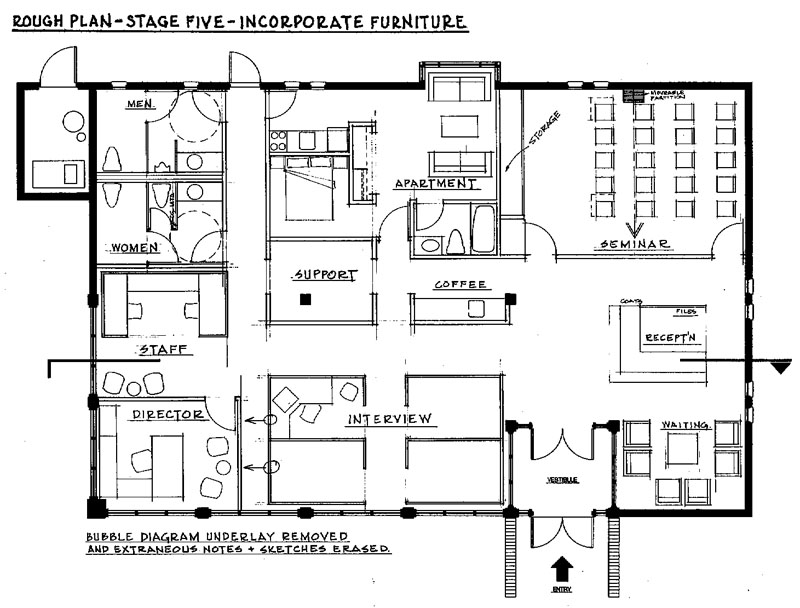
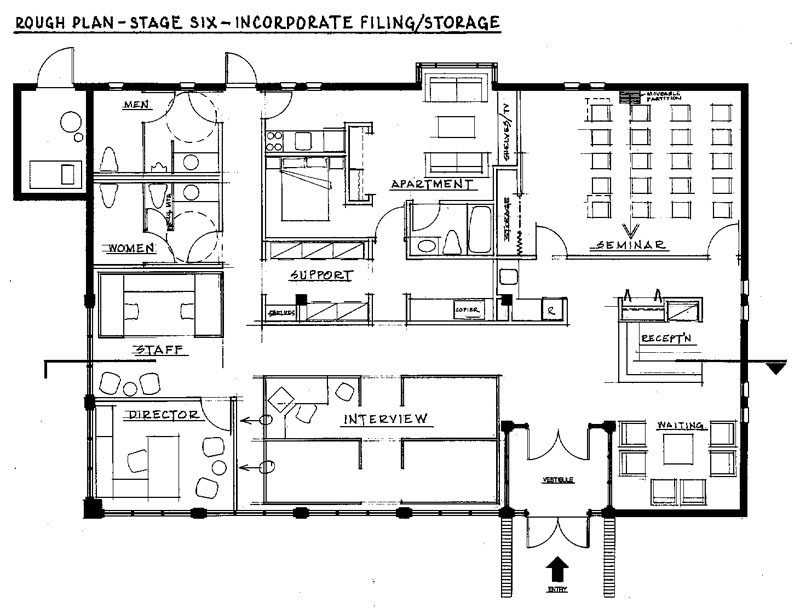
3.3.5 Refinement
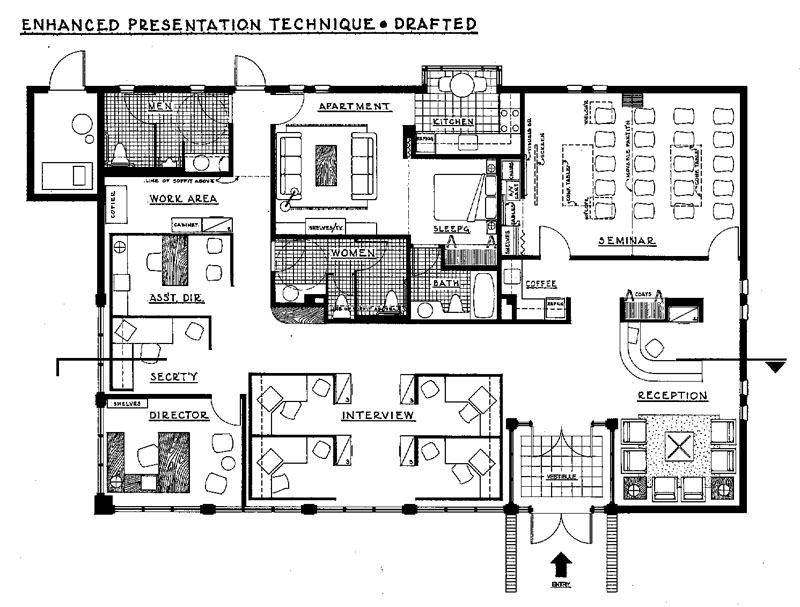
3.4 A final word on the IMPORTANCE OF SETTING DEADLINES...
"...Any cursory perusal of a fan/maker forum on the web reveals two distinct kinds of projects: the long, meandering, inconsistently updated but impressively detailed effort and the hell-bent-for-leather, tearing-toward-a-deadline build. Solutions to problems of the first type are often methodical and obvious. Solutions for the second type are much more likely to be innovative, elegant, and shockingly simple..." (Savage, 2013).
Some last words of wisdom...
"The Future of Design Is More Than Making Apple iOS Flat." (Maeda, 2013).
4.0 References
Brown, Jody. "This Foyer is going to be Epic." 13 Dec 2011. ArchDaily. Accessed 26 Aug 2013. <http://www.archdaily.com/191980>
Buxton, Bill (2007). Sketching User Experiences: Getting the Design Right and the Right Design. New York, NY: Elsevier Incorporated.
Karlen, Mark (2009). Space Planning Basics. Hoboken, NJ: John Wiley & Sons. (Latest edition).
Maeda, John. "The Future of Design Is More Than Making Apple iOS Flat'." 6 June 2013. Wired Magazine. Accessed 29 Aug 2013. <http://www.wired.com/opinion/2013/06/the-future-of-design-is-more-than-making-apple-ios-flat/>
Merchant, Nilofer. "Kill Your Meeting Room - The Future's in Walking and Talking." 8 Mar 2013. WIred Magazine. Accessed 26 Aug 2013. <http://www.wired.com/opinion/2013/03/how-technology-can-make-us-stand-up/>
Savage, Adam. "Under the Gun: When Less Time Can Mean Better Problem-Solving." 11 Feb 2013. Wired Magazine. Accessed 29 Aug 2013. <http://www.wired.com/design/2013/02/under-the-gun/>